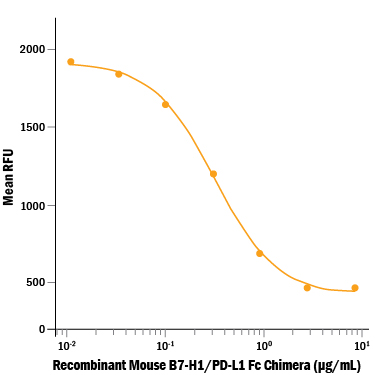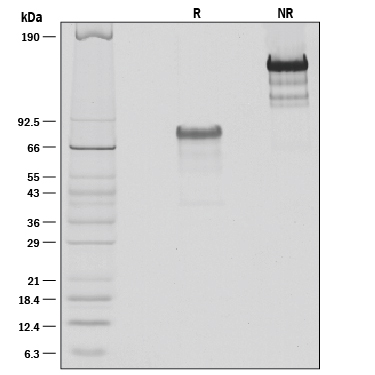Recombinant Mouse PD-L1/B7-H1 Fc Chimera Protein, CF
Recombinant Mouse PD-L1/B7-H1 Fc Chimera Protein, CF Summary
Product Specifications
| Mouse PD-L1 (Phe19-Thr238) Accession # Q9EP73 |
IEGRMD | Human IgG1 (Pro100-Lys330) |
| N-terminus | C-terminus | |
Analysis
Product Datasheets
Carrier Free
CF stands for Carrier Free (CF). We typically add Bovine Serum Albumin (BSA) as a carrier protein to our recombinant proteins. Adding a carrier protein enhances protein stability, increases shelf-life, and allows the recombinant protein to be stored at a more dilute concentration. The carrier free version does not contain BSA.
In general, we advise purchasing the recombinant protein with BSA for use in cell or tissue culture, or as an ELISA standard. In contrast, the carrier free protein is recommended for applications, in which the presence of BSA could interfere.
1019-B7
| Formulation | Lyophilized from a 0.2 μm filtered solution in PBS. |
| Reconstitution | Reconstitute at 100 μg/mL in sterile PBS. |
| Shipping | The product is shipped at ambient temperature. Upon receipt, store it immediately at the temperature recommended below. |
| Stability & Storage: | Use a manual defrost freezer and avoid repeated freeze-thaw cycles.
|
Scientific Data
 View Larger
View Larger
Recombinant Mouse PD-L1/B7-H1 Fc Chimera (Catalog # 1019-B7) inhibits anti-CD3-induced cell proliferation of stimulated mouse T cells. The ED50 for this effect is 0.15-0.75 μg/mL.
 View Larger
View Larger
1 μg/lane of Recombinant Mouse PD-L1/B7-H1 Fc Chimera was resolved with SDS-PAGE under reducing (R) and non-reducing (NR) conditions and visualized by silver staining, showing bands at 79 kDa and 150 kDa, respectively.
Reconstitution Calculator
Background: PD-L1/B7-H1
B7-H1, also known as PD-L1 and CD274, is an approximately 65 kDa transmembrane glycoprotein in the B7 family of immune regulatory molecules (1). Mature mouse B7-H1 consists of a 221 amino acid (aa) extracellular domain (ECD) with two immunoglobulin-like domains, a 21 aa transmembrane segment, and a 30 aa cytoplasmic domain (2). Within the ECD, mouse B7-H1 shares 73% and 86% aa sequence identity with human and rat B7-H1, respectively. B7-H1 is expressed on inflammatory-activated immune cells including macrophages, T cells, and B cells (2-5), keratinocytes (6, 7), enothelial and intestinal epithelial cells (6, 8), as well as a variety of carcinomas and melanoma (9, 10). B7-H1 binds to T cell B7-1/CD80 and PD-1 (5, 6, 10-13). It suppresses T cell activation and proliferation (3, 6, 12, 14) and induces the apoptosis of activated T cells (9). It plays a role in the development of immune tolerance by promoting T cell anergy (5, 12) and enhancing regulatory T cell development (14). B7-H1 favors the development of anti-inflammatory IL-10 and IL-22 producing dendritic cells (3, 8) and inhibits the development of Th17 cells (14). In cancer, B7-H1 provides resistance to T cell mediated lysis, enhances EMT, and enhances the tumorigenic function of Th22 cells (4, 7, 10, 13).
- Ceeraz, S. et al. (2013) Trends Immunol. 34:556.
- Tamura, H. et al. (2001) Blood 97:1809.
- Chen, L. et al. (2007) J. Immunol. 178:6634.
- Kuang, D.-M. et al. (2014) J. Clin. Invest. 124:4657.
- Tsushima, F. et al. (2007) Blood 110:180.
- Mazanet, M.M. and C.C.W. Hughes (2002) J. Immunol. 169:3581.
- Cao, Y. et al. (2010) Cancer Res. 71:1235.
- Scandiuzzi, L. et al. (2014) Cell Rep. 6:625.
- Dong, H. et al. (2002) Nat. Med. 8:793.
- Azuma, T. et al. (2008) Blood 111:3635.
- Butte, M.J. et al. (2008) Mol. Immunol. 45:3567.
- Park, J.-J. et al. (2010) Blood 116:1291.
- Ritprajak, P. et al. (2010) J. Immunol. 184:4918.
- Herold, M. et al. (2015) J. Immunol. 195:3584.
Citations for Recombinant Mouse PD-L1/B7-H1 Fc Chimera Protein, CF
R&D Systems personnel manually curate a database that contains references using R&D Systems products. The data collected includes not only links to publications in PubMed, but also provides information about sample types, species, and experimental conditions.
23
Citations: Showing 1 - 10
Filter your results:
Filter by:
-
PD-1 regulation of pathogenic IL-17-secreting ?? T cells in experimental autoimmune encephalomyelitis
Authors: Leane, CM;Sutton, CE;Moran, B;Mills, KHG;
European journal of immunology
Species: Transgenic Mouse, Mouse
Sample Types: Whole Cells
Applications: Bioassay -
Orthogonal cytokine engineering enables novel synthetic effector states escaping canonical exhaustion in tumor-rejecting CD8+ T cells
Authors: Corria-Osorio J, Carmona SJ, Stefanidis E, Andreatta M, Ortiz-Miranda Y, Muller T, Rota IA, Crespo I, Seijo B, Castro W, Jimenez-Luna C, Scarpellino L, Ronet C, Spill A, Lanitis E, Romero P, Luther SA, Irving M, Coukos G
Nat Immunol. 2023; 24(5): 869–883.
Species: Mouse
Sample Types: Whole Cells
Applications: Bioassay -
Neuronally expressed PDL1, not PD1, suppresses acute nociception
Authors: KA Meerschaer, BS Edwards, AY Epouhe, B Jefferson, R Friedman, OL Babyok, JK Moy, F Kehinde, C Liu, CJ Workman, DAA Vignali, KM Albers, HR Koerber, MS Gold, BM Davis, NN Scheff, JL Saloman
Brain, Behavior, and Immunity, 2022-09-08;106(0):233-246.
Species: Mouse
Sample Types: In Vivo
Applications: In Vivo -
Distinct antibody clones detect PD-1 checkpoint expression and block PD-L1 interactions on live murine melanoma cells
Authors: C Martins, M Silva, E Rasbach, P Singh, Y Itoh, JB Williams, E Statham, A Meurer, DV Martinez, A Brandenbur, MV Heppt, SR Barthel, T Schatton
Scientific Reports, 2022-07-21;12(1):12491.
Species: Mouse
Sample Types: Whole Cells
Applications: Bioassay -
Computational design of a synthetic PD-1 agonist
Authors: CM Bryan, GJ Rocklin, MJ Bick, A Ford, S Majri-Morr, AV Kroll, CJ Miller, L Carter, I Goreshnik, A Kang, F DiMaio, KV Tarbell, D Baker
Proceedings of the National Academy of Sciences of the United States of America, 2021-07-20;118(29):.
Species: Mouse
Sample Types: Whole Cells
Applications: Bioassay -
PD-L1+ neutrophils contribute to injury-induced infection susceptibility
Authors: A Thanabalas, AJ Chiang, C Morehouse, M Camara, S Hawkins, AE Keller, AC Koksal, CS Caceres, AA Berlin, N Holoweckyj, VN Takahashi, L Cheng, M de Los Rey, M Pelletier, AC Patera, B Sellman, S Hess, M Marelli, CC Boo, TS Cohen, A DiGiandome
Science Advances, 2021-03-05;7(10):.
Species: Mouse
Sample Types: In Vivo
Applications: Bioassay -
ICOS agonism by JTX-2011 (vopratelimab) requires initial T cell priming and Fc cross-linking for optimal T cell activation and anti-tumor immunity in preclinical models
Authors: A Hanson, K Elpek, E Duong, L Shallberg, M Fan, C Johnson, M Wallace, GR Mabry, S Sazinsky, L Pepper, CJ Shu, S Sathyanara, S Zuerndorfe, T Simpson, M Gostissa, M Briskin, D Law, J Michaelson, CJ Harvey
PLoS ONE, 2020-09-24;15(9):e0239595.
Species: Human
Sample Types: Whole Cells
Applications: Bioassay -
Quantification of Pharmacokinetic Profiles of PD-1/PD-L1 Antibodies by Validated ELISAs
Authors: S Zalba, AM Contreras-, E Martisova, R Debets, C Smerdou, MJ Garrido
Pharmaceutics, 2020-06-26;12(6):.
Species: Mouse
Sample Types: Plasma
Applications: ELISA Capture -
Mechanistic dissection of the PD-L1:B7-1 co-inhibitory immune complex
Authors: SC Garrett-Th, A Massimi, EV Fedorov, JB Bonanno, L Scandiuzzi, B Hillerich, RD Seidel, JD Love, SJ Garforth, C Guha, SC Almo
PLoS ONE, 2020-06-04;15(6):e0233578.
Species: Mouse
Sample Types: Whole Cells
Applications: Bioassay -
Smad7 Controls Immunoregulatory PDL2/1-PD1 Signaling in Intestinal Inflammation and Autoimmunity
Authors: LP Garo, AK Ajay, M Fujiwara, V Beynon, C Kuhn, G Gabriely, S Sadhukan, R Raheja, S Rubino, HL Weiner, G Murugaiyan
Cell Rep, 2019-09-24;28(13):3353-3366.e5.
Species: Mouse
Sample Types: In Vivo
Applications: In Vivo -
Improved survival of chimeric antigen receptor-engineered T (CAR-T) and tumor-specific T cells caused by anti-programmed cell death protein 1 single-chain variable fragment-producing CAR-T cells
Authors: M Nakajima, Y Sakoda, K Adachi, H Nagano, K Tamada
Cancer Sci., 2019-09-17;110(10):3079-3088.
Species: Mouse
Sample Types: Serum, Whole Cells
Applications: ELISA (Capture), Flow Cytometry -
Tolerizing CTL by Sustained Hepatic PD-L1 Expression Provides a New Therapy Approach in Mouse Sepsis
Authors: A von Knethe, A Schäfer, L Kuchler, T Knape, U Christen, E Hintermann, B Fi beta lthaler, K Schröder, RP Brandes, B Genz, K Abshagen, BM Pützer, LK Sha, A Weigert, SN Syed, M Schulz, AM Shah, A Ernst, M Putyrski, F Finkelmeie, M Pesic, F Greten, M Hogardt, VAJ Kempf, S Gunne, MJ Parnham, B Brüne
Theranostics, 2019-03-16;9(7):2003-2016.
Species: Mouse
Sample Types: cell culture
Applications: Bioassay, In Vivo -
Indirubin attenuates mouse psoriasis-like skin lesion in a CD274-dependent manner: an achievement of RNA sequencing
Authors: X Xue, J Wu, J Li, J Xu, H Dai, C Tao, C Li, J Hu
Biosci. Rep., 2018-11-23;0(0):.
Species: Mouse
Sample Types: In Vivo
Applications: In Vivo -
Combined blockade of IL-6 and PD-1/PD-L1 signaling abrogates mutual regulation of their immunosuppressive effects in the tumor microenvironment
Authors: H Tsukamoto, K Fujieda, A Miyashita, S Fukushima, T Ikeda, Y Kubo, S Senju, H Ihn, Y Nishimura, H Oshiumi
Cancer Res., 2018-07-02;0(0):.
Species: Mouse
Sample Types: Whole Tissue
Applications: Bioassay -
Intratumoral delivery of an adenoviral vector carrying the SOCS-1 gene enhances T cell-mediated anti-tumor immunity by suppressing PD-L1
Authors: S Nakagawa, S Serada, R Kakubari, K Hiramatsu, T Sugase, S Matsuzaki, S Matsuzaki, Y Ueda, K Yoshino, T Ohkawara, M Fujimoto, T Kishimoto, T Kimura, T Naka
Mol. Cancer Ther., 2018-06-11;0(0):.
Species: Mouse
Sample Types: In Vivo
Applications: In Vivo -
Antibody-drug conjugates bearing pyrrolobenzodiazepine or tubulysin payloads are immunomodulatory and synergize with multiple immunotherapies
Authors: J Rios-Doria, J Harper, R Rothstein, L Wetzel, J Chesebroug, AM Marrero, C Chen, P Strout, K Mulgrew, KA McGlinchey, R Fleming, B Bezabeh, J Meekin, D Stewart, M Kennedy, P Martin, A Buchanan, N Dimasi, EF Michelotti, RE Hollingswo
Cancer Res, 2017-03-10;0(0):.
Species: Mouse
Sample Types: In Vivo
Applications: In Vivo -
HTLV-1 bZIP Factor Enhances T-Cell Proliferation by Impeding the Suppressive Signaling of Co-inhibitory Receptors
Authors: H Kinosada, JI Yasunaga, K Shimura, P Miyazato, C Onishi, T Iyoda, K Inaba, M Matsuoka
PLoS Pathog, 2017-01-03;13(1):e1006120.
-
Obesity accelerates T cell senescence in murine visceral adipose tissue
Authors: Motoaki Sano
J. Clin. Invest., 2016-11-07;0(0):.
Species: Mouse
Sample Types: Whole Cells
Applications: Bioassay -
Vectorization in an oncolytic vaccinia virus of an antibody, a Fab and a scFv against programmed cell death -1 (PD-1) allows their intratumoral delivery and an improved tumor-growth inhibition
Authors: Jean-Baptiste Marchand
Oncoimmunology, 2016-09-09;5(10):e1220467.
Species: Mouse
Sample Types: Protein, Whole Cells
Applications: Bioassay -
Differential control of CD4(+) T-cell subsets by the PD-1/PD-L1 axis in a mouse model of allergic asthma.
Authors: McAlees J, Lajoie S, Dienger K, Sproles A, Richgels P, Yang Y, Khodoun M, Azuma M, Yagita H, Fulkerson P, Wills-Karp M, Lewkowich I
Eur J Immunol, 2015-02-26;45(4):1019-29.
Species: Mouse
Sample Types: Whole Cells
Applications: Bioassay -
RGMb is a novel binding partner for PD-L2 and its engagement with PD-L2 promotes respiratory tolerance.
Authors: Xiao, Yanping, Yu, Sanhong, Zhu, Baogong, Bedoret, Denis, Bu, Xia, Francisco, Loise M, Hua, Ping, Duke-Cohan, Jonathan, Umetsu, Dale T, Sharpe, Arlene H, DeKruyff, Rosemari, Freeman, Gordon J
J Exp Med, 2014-04-21;211(5):943-59.
Species: Mouse
Sample Types: Antibody
Applications: ELISA (Capture) -
Soluble production of a biologically active single-chain antibody against murine PD-L1 in Escherichia coli.
Authors: Drees J, Augustin L, Mertensotto M, Schottel J, Leonard A, Saltzman D
Protein Expr Purif, 2013-11-08;94(0):60-6.
Species: Mouse
Sample Types: Antibody, Whole Cells
Applications: Bioassay, Enzyme Assay -
Programmed death-1 ligand 1 interacts specifically with the B7-1 costimulatory molecule to inhibit T cell responses.
Authors: Butte MJ, Keir ME, Phamduy TB, Sharpe AH, Freeman GJ
Immunity, 2007-07-12;27(1):111-22.
Applications: Surface Plasmon Resonance
FAQs
-
Recombinant Mouse PD-L1/B7-H1 Fc Chimera Protein, CF (Catalog # 1019-B7) is a Mouse PD-L1/B7-H1 protein with a human Fc chimera. What is an appropriate isotype control for the Fc?
Recombinant Human IgG1 Fc Protein, CF (Catalog # 110-HG) is an appropriate isotype control for proteins with a human Fc chimera.
Reviews for Recombinant Mouse PD-L1/B7-H1 Fc Chimera Protein, CF
Average Rating: 5 (Based on 13 Reviews)
Have you used Recombinant Mouse PD-L1/B7-H1 Fc Chimera Protein, CF?
Submit a review and receive an Amazon gift card.
$25/€18/£15/$25CAN/¥75 Yuan/¥2500 Yen for a review with an image
$10/€7/£6/$10 CAD/¥70 Yuan/¥1110 Yen for a review without an image
Filter by:
0.5 ug mPD-L1-hIgG1 (Cat# 1019-B7-100) was added to cells expressing mPD-1 GFP. Binding was detected with anti-human 594 secondary antibody.



